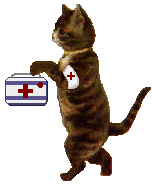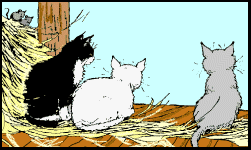
First Aid For Cats

Here are a few first aid tips for injuries and other kitty complaints!
It is intended that these tips be used in conjunction with a veterinary
consultation. Do not attempt to cure your cat alone! Consultation
over the phone and/or a trip to the veterinarian, depending on the
severity of the problem is vital. Always check with your vet before
administering treatment and follow his/her advice! :-) I hope that
you find these useful! :-)
Build a First Aid Kit
These are items to have on hand in case of emergency:
Rolls of gauze and adhesive tape. Infant Mittens
Gauze Dressing Pads Laxatone Nutrical (both from vet)
Antibacterial Skin and Eye ointment (from vet)
Epson Salts Peroxide Tweezers Cotton Balls
Procedures |
|
Shock |
Shock may not appear until several hours after the incident has occurred. With this in mind, please monitor your cat for at least 24 hours after the incident. Stop any bleeding that may occur. Move cat to a warm, quiet area. Make sure that cat is on side with the head lower than the rest of the body. Give CPR or artificial respiration,if necessary. Do not give water or food. See vet immediately. |
Artificial Respiration and CPR |
If cat has a heartbeat, begin Artificial Respiration: Remove collar, open mouth and pull tongue forward. Pull head and neck forward, put hand on ribs, push down suddenly and release. Repeat every 5 seconds. CPR: Place hand so that thumb is on cat's chest at the elbow and fingers on the opposite side of the chest. Squeeze gently giving one compression per second. Between 5 compressions, give artificial respiration using technique above. Continue rhythm until cat is revived or if possible, taken to the vet. |
Burns |
For superficial burns, apply ice packs to area or immerse area in cold water. Dry gently. remove hair from around wound to minimize infection. Do not apply oils, butter or human medications! If necessary, apply a thin line of eye ointment. Cover with dressing and hold in place with a bandage. Check daily. If burn is serious or becomes infected, see your vet immediately. |
Insect Bites or Stings |
Bees and Wasps: Remove stinger. If sting is in mouth, rinse mouth with 1 tsp baking soda to 1 pint water. If on skin, gently swab area with rubbing alcohol and follow with a paste of baking soda and water. Use for any bite or sting that causes a mild local reaction. Ticks: Cover tick with alcohol soaked cotton until tick backs out. Grasp tick with tweezers and remove making sure that head is intact, as remaining fragments can cause infection. Swab ear with alcohol, allowing to dry. Do not try to burn tick out with a match or cigarette! Monitor cat for signs of allergy and see vet immediately if signs occur. |
Scratches & Abrasions (body & head) |
For minor scratches, smooth fur down around wound with ointment to keep hair from entering the wound. Clean wound with cotton ball and peroxide. Apply ointment and cover with dressing pad. Apply tape to pad, securing so that cat cannot untie the dressing. Change dressing daily, monitoring healing progress. |
Scratches & Abrasions (paws) |
Follow above procedure with following exceptions: Instead of using a dressing pad, secure an infant mitten on the paw with adhesive tape. Be careful not to wind the tape too tightly. An infant mitten can offer protection while your cat can move freely and will prevent infection from entering wound while cat uses litter box. Alternate: For a more serious wound or your preference, soak cat's paw in 1 part Epson Salts, 8 parts water for 5 min. |
Heat Stroke |
Cats are very sensitive to overheating. If your cat is too warm, s/he may begin to breathe rapidly, repeatedly lick fur, pant, salivate, or vomit. If you're seeing any of these symptoms, remove cat to cooler area, if possible. Mild heat stroke can be treated by immersing cat in cold water or wrapping in cool, wet towels to reduce body temperature. For serious heat stroke (weakness) or severe (bleeding at nostrils), see your vet, immediately! Prevention, in this case is the best cure. :-) |
Mild Frostbite |
The appearance of frostbitten skin will be pale at first and when thawed, become scaly and red. As frostbites are very painful, take care in handling your cat. Move cat to a warm place. Apply warm, moist packs or use a blow dryer on medium setting on affected area. Do not rub area, as this could damage area or cause loss of tissue. Apply eye ointment to affected area and call vet. S/he might want to prescribe antibiotics for prevention of infection or sedatives for pain. If not healed within 5-10 days, see vet! Gangrene can form and amputation may be necessary. Best prevention is to keep your cat inside! :-) |
Severe Frostbite |
If the body temperature is extremely low (100.4-102.5 is normal), immerse cat in warm (102-105 degrees) water to increase body temperature. Dry thoroughly and gently with a warm blow dryer. Wrap cat for warmth. Treat signs of shock and see vet immediately. |
Note: A cat in pain won't always recognize his/her owner. Always approach cautiously,
moving slowly and speaking in a soft voice. Make sure the cat realizes that you're there
to help. If it becomes necessary to restrain the cat, wrap bandage gently but firmly around
legs. For the extremely agressive cat, cover cat with a towel or blanket and wrap firmly.

Any injury to a cat's eyes should be seen
to immediately by a veterinarian.

![]() Waltham First
Aid Guide For Cats
Waltham First
Aid Guide For Cats

Cats who go outside are particularly vulnerable
to injury. If you let your cat out, be sure to examine
him/her once back inside with a lot of loving to
keep suspicion at a minimum, of course! :-)
To: Is Your Cat Sick? To: Dangerous Substances

If you see a long piece of yarn or thread hanging
from your cat's mouth, do not attempt to pull the
length back out. This can cut the delicate esophagus
and cause greater injury. Instead, cut the string as
closely to the mouth as possible and monitor your
cat's stools. If you do not, see the substance in the
stool and your cat shows signs of pain, visit your
veterinarian, ASAP!
Disclaimer: This page is intended strictly as a guide. It has not been copied, rearranged
or stolen from any source. My thanks goes to my own two veterinarians for their patience
with my endless questions on these tips. Any resemblence to any other material, written or
otherwise is purely coincidental. Veterinary advice and/or treatment should always be the
first step taken in an emergency situation.




